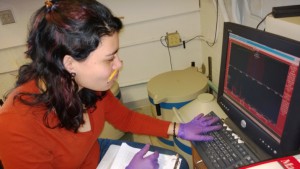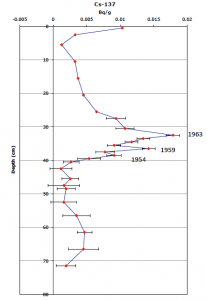Gamma Analysis and Isotope Dating
Germanium Isotope Counters (aka Gamma Counters)
We use a pair of Geranium Gamma Detectors to measure the levels of the Cs-137 and Pb-210 isotopes in cores. The presence of Cs-137 preserved in the sediments is associated with nuclear weapon testing, and its initiation is interpreted to correspond to around 1954. We use the peak trace of Cs-137 to determine the stratigraphic interval that was deposited in 1954.
Pb-210 activity within sediment can be used to estimate accretion rates. Pb-210 is a product of the uranium-decay series where Ra-226 within the crust decays to Rn-222. A fraction of the Rn-222 enters the atmosphere where it in turn decays to Pb-210, and then quickly precipitates out of the atmosphere, is deposited at the surface, and decays with a half-life of 22.3 years.
Both isotopes when coalescing with raindrops, will fall to the atmosphere and be absorped and adsorped by plant matter in a marsh. As sea level rises, the sediments accumulate vertically covering older sediments and seasonal plant matter. This continues over time and a vertical accretion of mud accumulates leaving a record of the past. We sample the mud by coring and collecting through it, then run dried and crushed mud samples through the Gemanium Gamma Detector to measure Cs-137 and Pb-210 levels. The detectors are passive detectors that measure the amount of gamma radiation emitted by each sample. Each isotope emits gamma rays at a distinct energy level when it goes through nuclear decay, and so by measuring the number of gamma rays at each level we can determine the amount of each isotope in the sample. We generate a plot that helps us identify age estimates based on amounts of our trace isotopes.


